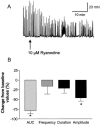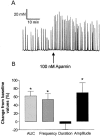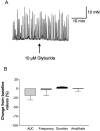Spontaneous phasic activity of the pig urinary bladder smooth muscle: characteristics and sensitivity to potassium channel modulators
- PMID: 11834611
- PMCID: PMC1573168
- DOI: 10.1038/sj.bjp.0704499
Spontaneous phasic activity of the pig urinary bladder smooth muscle: characteristics and sensitivity to potassium channel modulators
Abstract
A hallmark for unstable bladder contractions is hyperexcitability and changes in the nature of spontaneous phasic activity of the bladder smooth muscle. In this study, we have characterized the spontaneous activity of the urinary bladder smooth muscle from the pig, a widely used model for studying human bladder function. Our studies demonstrate that phasic activity of the pig detrusor is myogenic and is influenced by the presence of urothelium. Denuded strips exhibit robust spontaneous activity measured as mean area under the contraction curve (AUC=188.9+/-15.63 mNs) compared to intact strips (AUC=7.3+/-1.94 mNs). Spontaneous phasic activity, particularly the amplitude, is dependent on both calcium entry through voltage-dependent calcium channels and release from ryanodine receptors as shown by inhibition of spontaneous activity by nifedipine and ryanodine respectively. Inhibition of BK(Ca) channels by iberiotoxin (100 nM) resulted in an increase in contraction amplitude (89.1+/-20.4%) and frequency (92.5+/-31.0%). The SK(Ca) channel blocker apamin (100 nM) also increased contraction amplitude (69.1+/-24.3%) and frequency (53.5+/-13.6%) demonstrating that these mechanisms are critical to the regulation of phasic spontaneous activity. Inhibition of K(ATP) channels by glyburide (10 microM) did not significantly alter myogenic contractions (AUC=18.5+/-12.3%). However, K(ATP) channel openers (KCOs) showed an exquisite sensitivity for suppression of spontaneous myogenic activity. KCOs were generally 15 fold more potent in suppressing spontaneous activity compared to contractions evoked by electrical field-stimulation. These studies suggest that potassium channel modulation, particularly K(ATP) channels, may offer a unique mechanism for controlling spontaneous myogenic activity especially those associated with the hyperexcitability occurring in unstable bladders.
Figures








References
-
- ANDERSSON K.-E. Clinical pharmacology of potassium channel openers. Pharmacol. Toxicol. 1992;70:244–254. - PubMed
-
- BRADING A.F. Ion channels and control of contractile activity in urinary bladder smooth muscle. Jpn. J. Pharmacol. 1992;58 suppl 2:120–127. - PubMed
-
- BRADING A.F. The pathophysiological changes in the bladder obstructed by benign prostatic hyperplasia. Br. J. Urol. 1994;74:133. - PubMed
-
- BRADING A.F. A myogenic basis for the overactive bladder. Urol. 1997;50 suppl 6A:57–67. - PubMed
-
- BUCKNER S.A., MILICIC I., DAZA A., DAVIS-TABER R., SCOTT V.E., SULLIVAN J.P., BRIONI J.D. Pharmacological and molecular analysis of ATP-sensitive K(+) channels in the pig and human detrusor. Eur. J. Pharmacol. 2000;400:287–295. - PubMed
MeSH terms
Substances
LinkOut - more resources
Full Text Sources
Other Literature Sources

